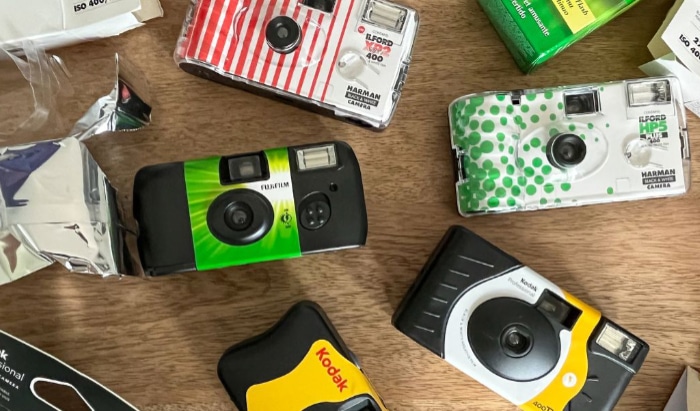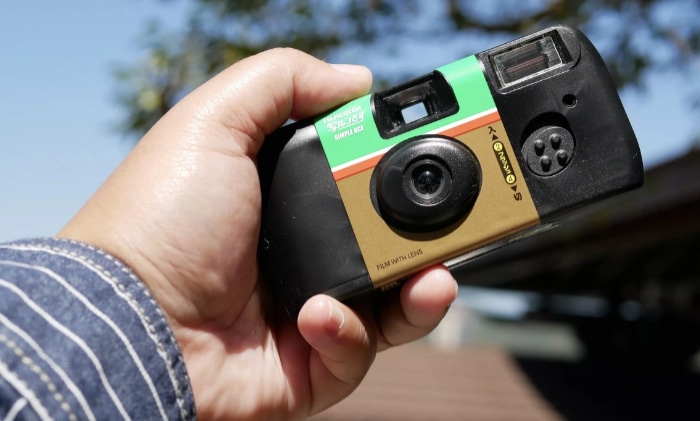Do Disposable Cameras Expire? A Guide to Lifespan

Capturing moments with a tactile and nostalgic flair often sends people reaching for a unique tool: the disposable camera. Yet, an underlying question haunts both seasoned photographers and casual snap-takers—do these one-use wonders actually expire? This query isn't merely academic; it impacts everything from the vibrancy of your captured memories to the financial wisdom of investing in such devices.
Grasping the concept of disposable camera expiration is essential, whether you're planning a photo-walk, attending an event, or simply preserving a moment in time. Stick with us to uncover the intriguing facts that can influence whether you click that shutter button or reconsider your options.
The Anatomy of a Disposable Camera
When considering the shelf life of a disposable camera, one must first understand its basic components and how they function together to produce a photograph.
The Lens and Shutter Mechanism
The lens serves as the eye of the disposable camera. Generally made of plastic, it focuses incoming light onto the film.
Attached to the lens is the shutter mechanism, responsible for controlling the amount of light that reaches the film. When you press the camera's button, the shutter opens briefly and then closes, thus exposing the film to light and capturing an image.
Photographic Film
The heart of a disposable camera is its photographic film. Usually, a roll of 35mm film is preloaded into the device. The film comprises multiple layers of chemicals that react to light exposure. It's this reaction that allows the creation of a permanent image.
Internal Flash Circuit
Many disposable cameras come equipped with an internal flash circuit, which consists of a capacitor, a transformer, and a xenon flash tube. When activated, the flash provides additional lighting, enhancing the quality of the picture in low-light conditions.
Battery
While some disposable cameras can operate without batteries, those with flash units require a small, built-in battery. The battery stores electrical charge, which is released to power the flash when needed.
Exterior Casing
The exterior casing of a disposable camera usually consists of plastic and holds all internal components together. The casing protects the film from light exposure until it is intentionally exposed through the lens. It often has a simple design and a low manufacturing cost.
By examining these fundamental components and how they interact, we can gain a more comprehensive view of what exactly might ‘expire' in a disposable camera. Each part plays a crucial role, and understanding this can shed light on the overall longevity and effectiveness of the device.
Concept of Expiration in Photographic Film
When the term ‘expiration' comes up in the context of disposable cameras, it often specifically refers to the photographic film inside. This is because the film involves complex chemical processes that are susceptible to change over time.
What Does Expiring Mean for Photographic Film
The concept of expiration for photographic film is closely tied to its chemistry. Photographic film consists of a plastic base coated with an emulsion containing light-sensitive compounds, usually silver halide crystals.
Over time, these chemicals undergo changes, which may result in less accurate color reproduction, reduced contrast, and increased graininess in the photos.
Chemical Reactions Over Time
Photographic film is a hotbed of chemical activity. The silver halide crystals in the film emulsion are highly reactive to photons.
When exposed to light, these crystals undergo a photochemical reaction that forms a latent image. However, even when not deliberately exposed to light, slow chemical changes can still occur. These changes might manifest as fogging, color shifts, or loss of sensitivity, affecting the quality of the eventual photographs.
Environmental Factors and Expiration
The rate at which a film expires is not uniform and can be influenced by various environmental factors. Temperature and humidity, in particular, play significant roles.
Cold storage can slow down the rate of chemical decay, while hot and humid conditions can expedite it.
Effects on Photograph Quality
As film ages and its internal chemistry changes, several noticeable shifts occur in the quality of the photographs it can produce. Colors may become less vibrant, contrast could be diminished, and images may exhibit an overall muddy or foggy appearance.
Some photographers find artistic value in these effects, but for those looking for crisp, clear images, using expired film is a risk.
Shelf Life vs. Usable Life
When discussing the longevity of disposable cameras and their components, two terms frequently come up: shelf life and usable life. These terms, while often used interchangeably, have distinct meanings and implications for both consumers and photographers.
Defining Shelf Life
Shelf life refers to the period during which a disposable camera, when stored under appropriate conditions, retains its intended functionality without significant degradation. For disposable cameras, this often correlates with the expiration date printed on the packaging.
This date provides a general guideline for when the chemical integrity of the film is expected to remain stable.
Defining Usable Life
On the other hand, usable life pertains to the time frame within which the camera can still function to produce photographs, albeit possibly with compromised quality. Even past the printed expiration date, many cameras can capture images, although the outcomes may not meet the manufacturer's original specifications for color accuracy, contrast, and sharpness.
The Importance of Distinction
Confusing shelf life with usable life can lead to misunderstandings. For instance, you might discard a disposable camera simply because it has surpassed its shelf life, thinking it's unusable, when in fact, it may still be capable of capturing serviceable or even artistically interesting photos.
Conversely, using a camera within its usable life but past its shelf life may result in unexpectedly poor-quality photographs.
Factors Influencing Shelf and Usable Life
Several variables can affect both the shelf and usable life of a disposable camera, such as storage conditions and the camera's inherent build quality. For example, a camera stored in a cool, dry environment is likely to have a longer usable life compared to one stored in hot and humid conditions.
Storage Conditions and Their Impact

Storage conditions play a significant role in determining the longevity and functionality of disposable cameras. Proper storage can prolong both the shelf and usable life of the device, while poor storage conditions can accelerate its degradation.
Temperature and Its Effects
Temperature is a critical factor affecting disposable cameras. Chemical reactions within the photographic film are sensitive to temperature variations.
Cold temperatures tend to slow down these reactions, thereby prolonging the camera's shelf life. On the other hand, high temperatures can accelerate chemical decay, reducing both the shelf and usable life.
Role of Humidity
Humidity, or the amount of moisture in the air, is another crucial factor. Excessive humidity can lead to condensation inside the camera, which may result in water damage and compromised photo quality.
In contrast, extremely low humidity could dry out the film emulsion, also affecting image quality negatively.
Exposure to Light
Although disposable cameras are designed to protect the internal film from light exposure, extended exposure to bright light or direct sunlight can compromise the camera's integrity. It can lead to light leaks, which can ruin or drastically affect the quality of your photographs.
Importance of Proper Packaging
Disposable cameras often come in sealed packaging that provides some level of protection against environmental factors. Once this packaging is opened, it's advisable to store the camera in a cool, dry place away from direct light.
Signs of an Expired Disposable Camera
Recognizing the signs of an expired disposable camera can save you from the disappointment of poor-quality photographs. The characteristics of an expired camera are often subtle but discernible upon close inspection.
Visual Inspection of the Camera
The most straightforward method to assess whether a disposable camera has expired is a visual inspection. Signs of wear and tear, such as a damaged casing, can indicate that the camera may have been compromised.
Physical damage often implies that the internal components, including the film, could also be affected.
Image Quality Deterioration
One of the most telling signs of an expired disposable camera is a noticeable decline in image quality. You may observe images with reduced contrast, color shifts, and increased graininess.
These outcomes often occur due to aged film and the chemical changes that it undergoes over time.
Flash Inconsistency
An inconsistent or weak flash can also be an indicator of an expired camera. Batteries inside disposable cameras deteriorate over time, and this loss of charge can affect the camera's flash unit.
Consequently, poor flash performance can lead to underexposed photos, particularly in low-light conditions.
Film Winding Issues
Resistance or difficulty while winding the film to the next frame is another potential sign that the camera has expired. As cameras age, the mechanical parts may not function as smoothly, and this could result in uneven film winding, leading to overlapping or poorly framed photographs.
The Pros and Cons of Using an Expired Disposable Camera
The question of whether to use an expired disposable camera is not merely one of viability but also one of artistic choice and risk tolerance. Both benefits and drawbacks exist when it comes to using a camera past its prime.
Pros of Using an Expired Disposable Camera
Unpredictable Aesthetic Appeal
Expired film can produce unique and sometimes unpredictable effects such as shifts in color tones, increased grain, and variations in contrast. These effects can add a distinct texture and mood to your photos, giving them an artistic flair that may be hard to replicate with a digital filter.
Cost-Effectiveness
Expired disposable cameras are often available at discounted prices. If you're willing to experiment and can accept the risk of some compromised photos, you could save money on your photography projects.
Eco-Friendly Aspect
Using an expired disposable camera is a form of recycling. Rather than allowing it to end up as waste, you're giving the camera another chance to be useful, which can be seen as a more sustainable practice.
Cons of Using an Expired Disposable Camera
Risk of Poor Quality
The most significant downside of using expired film is the risk of reduced image quality. Expired film can produce photos that lack sharpness, have muted colors, or are fogged, making it unsuitable for critical photography work where high-quality results are essential.
Limited Reliability
An expired disposable camera is less reliable than a fresh one. You might encounter issues like flash malfunctions or winding problems, which could ruin crucial shots. The lack of reliability can be particularly problematic if you're using the camera for a significant event like a wedding or a vacation.
Difficulty in Post-Processing
The unique effects produced by expired film can sometimes be challenging to manage in post-processing. Correcting color shifts or reducing grain in editing software might not yield satisfactory results, thereby limiting your flexibility in the post-production phase.
Conclusion
Weighing the merits and limitations of using an expired disposable camera offers valuable insights into the complex relationship between time, chemistry, and photography. From the significance of shelf life and usable life to the various storage conditions that can influence a camera's performance, numerous factors contribute to the ultimate quality of your photos.
While recognizing the signs of an expired camera can save you from unpleasant surprises, understanding the pros and cons provides a nuanced perspective on whether the artistic gamble is worth taking. Therefore, the decision to use an expired disposable camera is not simply black and white but involves a multifaceted analysis of risks, rewards, and individual artistic intent.


